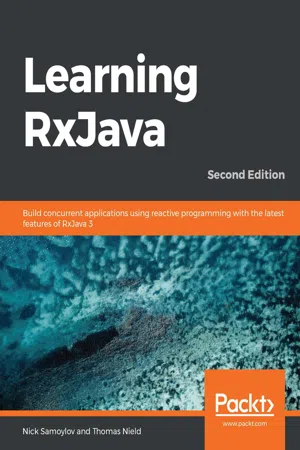
Learning RxJava
Build concurrent applications using reactive programming with the latest features of RxJava 3, 2nd Edition
- 412 pages
- English
- ePUB (mobile friendly)
- Available on iOS & Android
Learning RxJava
Build concurrent applications using reactive programming with the latest features of RxJava 3, 2nd Edition
About this book
Updated with the latest Maven coordinates, Java programming features, and API changes, this book is your guide to solving problems in writing asynchronous and event-based programs
Key Features
- Explore a variety of tools and techniques used to solve problems in implementing concurrency and parallelization
- Learn about core operators in RxJava that enable you to express your code logic productively
- Apply RxJava with Kotlin to create responsive Android apps with better user experience
Book Description
RxJava is not just a popular library for building asynchronous and event-based applications; it also enables you to create a cleaner and more readable code base. In this book, you'll cover the core fundamentals of reactive programming and learn how to design and implement reactive libraries and applications.
Learning RxJava will help you understand how reactive programming works and guide you in writing your first example in reactive code. You'll get to grips with the workings of Observable and Subscriber, and see how they are used in different contexts using real-world use cases. The book will also take you through multicasting and caching to help prevent redundant work with multiple Observers. You'll then learn how to create your own RxJava operators by reusing reactive logic. As you advance, you'll explore effective tools and libraries to test and debug RxJava code. Finally, you'll delve into RxAndroid extensions and use Kotlin features to streamline your Android apps.
By the end of this book, you'll become proficient in writing reactive code in Java and Kotlin to build concurrent applications, including Android applications.
What you will learn
- Discover different ways to create Observables, Observers, and Subscribers
- Multicast in order to push data to multiple destinations and cache and replay them
- Express RxJava idiomatically with the help of Kotlin features such as extension functions and data classes
- Become familiar with various operators available in RxJava to perform common transformations and tasks
- Explore RxJava's reactive types, including Flowable, Single, Maybe, and Completable
- Demystify Observables and how they express data and events as sequences
Who this book is for
This book is for Java developers who want to leverage reactive programming to develop more resilient and concurrent applications. If you're an RxJava user looking to get to grips with the latest features and updates in RxJava 3, this book is for you. Fundamental knowledge of core Java features and object-oriented programming will assist you in understanding the key concepts covered in this book.
Frequently asked questions
- Essential is ideal for learners and professionals who enjoy exploring a wide range of subjects. Access the Essential Library with 800,000+ trusted titles and best-sellers across business, personal growth, and the humanities. Includes unlimited reading time and Standard Read Aloud voice.
- Complete: Perfect for advanced learners and researchers needing full, unrestricted access. Unlock 1.4M+ books across hundreds of subjects, including academic and specialized titles. The Complete Plan also includes advanced features like Premium Read Aloud and Research Assistant.
Please note we cannot support devices running on iOS 13 and Android 7 or earlier. Learn more about using the app.
Information
Section 1: Foundations of Reactive Programming in Java
- Chapter 1, Thinking Reactively
- Chapter 2, Observable and Observer
- Chapter 3, Basic Operators
Thinking Reactively
- A brief history of Reactive Extensions and RxJava
- Thinking reactively
- Leveraging RxJava
- Setting up your first RxJava project
- Building your first reactive applications
- The differences between RxJava 1.x, 2.x, and 3.0
A brief history of ReactiveX and RxJava
Thinking reactively
Why should I learn RxJava?
Table of contents
- Title Page
- Copyright and Credits
- Dedication
- About Packt
- Contributors
- Preface
- Section 1: Foundations of Reactive Programming in Java
- Thinking Reactively
- Observable and Observer
- Basic Operators
- Section 2: Reactive Operators
- Combining Observables
- Multicasting, Replaying, and Caching
- Concurrency and Parallelization
- Switching, Throttling, Windowing, and Buffering
- Flowable and Backpressure
- Transformers and Custom Operators
- Section 3: Integration of RxJava applications
- Testing and Debugging
- RxJava on Android
- Using RxJava for Kotlin
- Appendix A: Introducing Lambda Expressions
- Appendix B: Functional Types
- Appendix C: Mixing Object-Oriented and Reactive Programming
- Appendix D: Materializing and Dematerializing
- Appendix E: Understanding Schedulers
- Other Books You May Enjoy